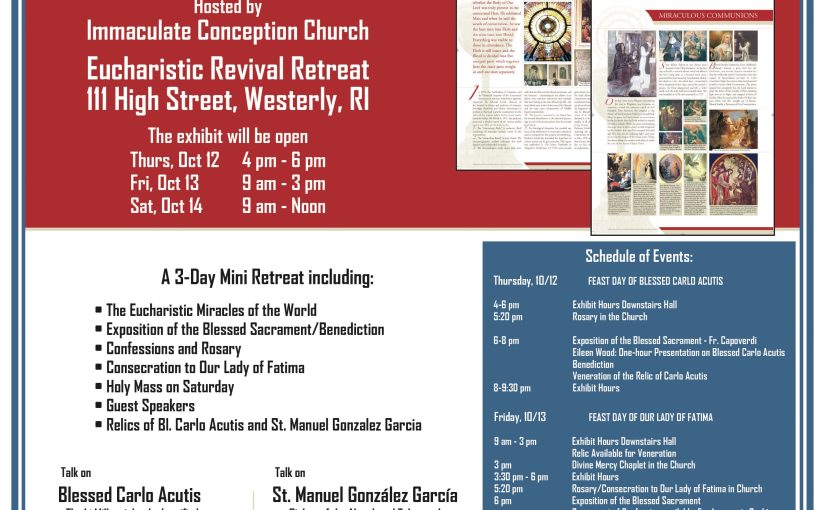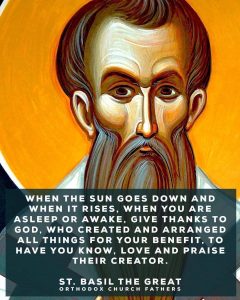 Thanksgiving to God is daily, both during the eucharistic celebration in the Church and in the sacrifice of love we offer upon the altar of every human heart, in every human temple. In fact, the Fathers unanimously say that it is the remedy that reverses the trajectory of loss because it reorients us to the norm of our human existence. (SM)
Thanksgiving to God is daily, both during the eucharistic celebration in the Church and in the sacrifice of love we offer upon the altar of every human heart, in every human temple. In fact, the Fathers unanimously say that it is the remedy that reverses the trajectory of loss because it reorients us to the norm of our human existence. (SM)
Tag: Eucharist
Eucharistic Exhibit

If you have not seen this exhibit curated by Blessed Carlo Acutis, I recommend that you avail yourself.
Blessed Pierre-René Rogue
Vincentian Father Pierre-René Rogue is a martyr of the French Revolution who suffered death by guillotine on 3 March 1796. His mother witnessed the death of her son. The Church beatified Father Pierre-René on 10 May 1934. His mortal remains can be found interred in the Cathedral of St. Peter (Vannes, France).
Rogue was a sensible, prudent and holy man who maintained good relations with civil authorities. Yet, in a time of persecution of the Catholic Church in France, Blessed Pierre-René was betrayed while bringing Viaticum on Christmas Eve 1795.
The liturgical memorial for Blessed Pierre-René is today according the most recent changes to the liturgical calendar, but he had initially his own liturgical memorial on May 8th. He is called a Martyr of the Eucharist.
Saint Peter Julian Eymard
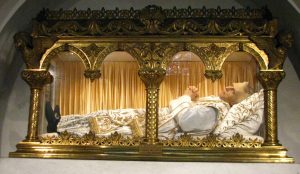 Saint Peter Julian Eymard (feastday today), whom Saint John Paul II called the “Apostle of the Eucharist.”
Saint Peter Julian Eymard (feastday today), whom Saint John Paul II called the “Apostle of the Eucharist.”
The prayer of the Church says:
O God, who adorned Saint Peter Julian Eymard with a wonderful love for the sacred mysteries of the Body and Blood of your Son, graciously grant, that we, too, may be worthy to receive the delights he drew from this divine banquet.
Saints are friends of saints, and saints beget saints: Eymard was a friend and contemporary of saints Peter Chanel, Marcellin Champagnat, and Blessed Basil Moreau. He died at the age of fifty-seven in La Mure on 1 August 1868.
At his canonization, Saint John XXIII said this of Saint Peter Julian:
It is also very fitting that the sacred ceremony occurs during the Second Vatican Ecumenical Council which has as its special purpose to see to it that the pearls of holiness belonging to the crown which encircles the head of the Church should sparkle and shine ever more and more. This extensive gathering of her holy shepherds united with the infallible successor of St Peter not only proposes and reaffirms once again the unchangeable truths left by the divine Master, but also clearly urges that daily, more and more, there be used those holy helps which make us possessors and sharers of divine grace. Furthermore, she enjoins on her children precepts designed to make the Christian way of life better lived.
The Council can therefore be said to have no other purpose than to show that here below, the Spouse of Christ possesses every kind of holiness both in deeds, in words, and in spiritual gifts of every kind; that here below she inspires her sons with that holy purpose of the Church expressed so clearly by the Redeemer of the human race: ‘Be perfect as your heavenly Father is perfect’ (Matt., 5: 48).
Once these things are understood, it is easy to see that Christians should glory in having such a mother whom everyone ought to admire because of her incredible beauty, divinely infused. Her grandeur does not shine because of gems or pearls that can be seen by human eyes, but rather glows in the splendour and grace which derive from the blood of her Founder and the marvellous virtue of many of her children. As a result, whoever calls himself a Christian ought to observe a way of life which in no way detracts from the supreme honour of their mother and which is not foreign to her precepts and teachings. No one can truly say that he loves his mother who is not afraid of dishonouring her beauty, even a little, by his way of life.
The Eucharist, Source of Sanctity
Eucharistic life: The Holy Eucharist is the source and the nourishment of all sanctity. Our Predecessor, St Leo the Great, expressed this when he said: ‘The participation in the Body and Blood of Jesus Christ has no other effect than to transform us into Him whom we receive.’
How visible is this progressive transformation into the very life of the divine Saviour, in the admirable development of the virtues of the saints canonised today! And what dealings of particular intimacy with Jesus Eucharistic do we not discover in their ascent to sanctity! The name of Peter Julian suffices to unveil to our eyes the splendid eucharistic triumphs to which, in spite of trials and difficulties of all kinds, he wanted to consecrate his life which prolongs itself in the family founded by him. This little child of five who was found on the altar, his forehead resting on the little door, was the same person who in time would found the Congregation of the Fathers of the Blessed Sacrament and that of the Servants of the Blessed Sacrament, and who would radiate into innumerable armies of priest adorers, his love and tenderness for Christ living in the Eucharist…
Marian Piety: At the side of Jesus there stands His Mother, the Queen of all the Saints, the source of sanctity in the Church of God and the first flower of its grace. Intimately associated with the redemption in the eternal plans of the Most High, the Blessed Virgin, as Severiano di Gabala expressed it in song, ‘is the Mother of salvation, the source of light become visible’. Hence filial piety is pleased to consider her at the beginning of all Christian life to ensure its harmonious development and to crown its fullness by her maternal presence.
Thus it is not surprising to meet the Blessed Virgin Mary in the life of the three new confessors whom she accompanies step by step. Saint Julian Eymard proposes her as a model to adorers, invoking her as ‘Our Lady of the Blessed Sacrament’…….
….pastoral radiance – the new saints prove it – can be described as the formation of good priests, with fervent souls of adorers, whose ranks have multiplied throughout the world… a
Perfect Adorer of the Blessed Sacrament
We now desire to add a word for the French pilgrims who have come to assist at the glorification of St Peter Julian Eymard, priest, confessor, founder of two religious families consecrated to the worship of the Blessed Sacrament.
He is a saint with whom We have been familiar for many years, as We said above, when as Apostolic Nuncio to France, Providence granted Us the happy opportunity to visit his native land, La Mure d’Isère, near Grenoble.
We saw with Our own eyes the poor bed, the humble dwelling where this faithful imitator of Christ gave up his beautiful soul to God. You can surmise, beloved Sons, with what emotion We recall that memory on this day when it is given Us to confer upon him the honours of canonisation.
The body of St Peter Julian Eymard is preserved in Paris: but the saint is also somehow present at Rome, in the person of his sons, the Priests of the Blessed Sacrament; it is also a sweet memory for Us to recall visits that We used to make to their Church of St Claude-des-Bourguignons (San Claudio), to unite Ourselves for a few moments to their silent adorations.
Besides St Vincent de Paul, St John Eudes, the Curé of Ars, Peter Julian Eymard takes his place in the ranks of the incomparable glory and honour of the country that witnessed their birth, but whose beneficial influence extends far beyond, namely, to the whole Church.
His characteristic distinction, the guiding thought of all his priestly activities, one may say, was the Eucharist: eucharistic worship and apostolate. Here, We would like to stress this fact in the presence of the Priests and of the Servants of the Most Blessed Sacrament, in presence also of the members of an Association which is dear to the heart of the Pope, that of the Priest Adorers assembled at this time in Rome, who have come in great numbers to honour this great friend of the Eucharist.
Yes, dear Sons, honour and celebrate with Us him who was so perfect an adorer of the Blessed Sacrament; after his example, always place at the centre of your thoughts, of your affections, of the undertakings of your zeal this incomparable source of all grace: the Mystery of Faith, which hides under its veils the Author Himself of grace, Jesus the Incarnate Word.
+++
Eymard is a great teacher for those who want to know more about the Eucharist and to have devotion to the Eucharist. It is this Mystery of the Faith which the Church infallibly teaches us is the center, summit and source of All.
The Eucharist in the now, and transcends time
The Eucharist is indelibly marked by the event of the Lord’s passion and death, of which it is not only a reminder but the sacramental re-presentation. It is the sacrifice of the Cross perpetuated down the ages.
The Church has received the Eucharist from Christ her Lord not as one gift – however precious – among so many others, but as the gift par excellence, for it is the gift of himself, of his person in his sacred humanity, as well as the gift of his saving work.
Nor does it remain confined to the past, since “all that Christ is – all that he did and suffered for all men – participates in the divine eternity, and so transcends all times”.
When the Church celebrates the Eucharist, the memorial of her Lord’s death and resurrection, this central event of salvation becomes really present and “the work of our redemption is carried out”
—EE 11
Thomas doubt exists today
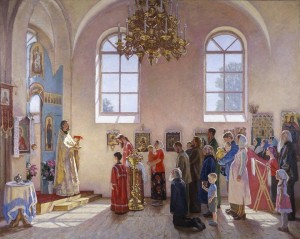 The Second Sunday of Easter presents to us the gospel reading of the Thomas doubting the existence of the risen Lord. The day has many names.
The Second Sunday of Easter presents to us the gospel reading of the Thomas doubting the existence of the risen Lord. The day has many names.
This gospel is proclaimed in the Novus Ordo, the Traditional and Byzantine Liturgies. In the Novus Ordo Liturgy today’s Mass can be referred to as Divine Mercy Sunday. The Latin Mass calls today Low Sunday (after the great solemn feast of Easter), or today is called dominica in albis depositis or “the Sunday in which the white clothes are put away”. Yet another way of referring to today is “Quasimodo Sunday”, because of the first words of the entrance antiphon sung for the Latin Mass which uses the words taken from Peter, Quasi modo geniti infantes, Halleluja, rationabile, sine dolo lac concupiscite (“yearn for the pure spiritual milk as if you were newborn children”).
In all these names, what can we say about this portion of the mystery of the faith in Christian today? If you think about the truth Jesus presented to the Apostles about Himself, it seems that truth is not as convincing as the doubt some put forward as reasonable. I am not quite sure I understand the penchant we have for doubting reasonableness of truth, but doubt exists and I have come to believe that God uses doubt to teach us the meaning of beauty, goodness and truth. Thomas, later revered as a saint and founder of the Church in India, tells us with certitude that the Lord is alive after death on the cross but only after verifying the physicality of the person Jesus when he says, My Lord and my God. He is said by Jesus that he blessed for what he has seen.
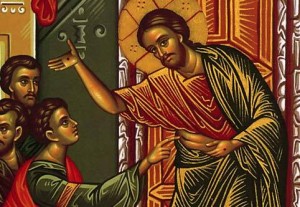 In the Byzantine Liturgy the Troparion of St Thomas is sung: While the tomb was sealed You shone forth from it, O Christ our Life, and while the doors remained closed, You stood among your Disciples, O Resurrection of all, and through them You restored a new spirit in us according to your great Mercy.
In the Byzantine Liturgy the Troparion of St Thomas is sung: While the tomb was sealed You shone forth from it, O Christ our Life, and while the doors remained closed, You stood among your Disciples, O Resurrection of all, and through them You restored a new spirit in us according to your great Mercy.
Today, we are faced with some similar doubts about Jesus, the sacraments and Christian life. Doubt is not new. And, perhaps Saint Thomas did us a favor in recognizing the concrete facts of our faith. Coming to Catholic faith means that we proclaim from whom salvation comes. It means that we are to be missionary so that all people come before the Lord.
One piece of our Catholic life is faith in the Holy Eucharist: faith in the Divine Presence here and now in the sacrament of the Eucharist. Teaching adults about First Holy Communion is difficult –think of the difficulty there is teaching third graders about the Presence of Jesus in Holy Communion. I recall what is called a Eucharistic miracle where a priest doubted the presence of Jesus in the sacred Host and the Lord gave the priest the a sign of Divine Presence by turing the host in heart muscle and the wine into blood.
The English theologian Monsignor Ronald Knox this about the Holy Eucharist: “We have never, as Christians, been truly faithful to Jesus, no matter our denomination. In the end none of us have truly followed those teachings which most characterize Jesus- We have not turned the other cheek. We have not forgiven our enemies. We have not purified our thoughts. We have not seen God in the poor. We have not kept our hearts pure and free from the things of this world. But we have been faithful in one very important way- we have kept the Eucharist going.”
Eucharistic Box or Reliquary
 I saw this post on FB today and thought about the various ways in which the Church “houses” the Eucharistic species of the Lord. To say that there is but one way to think liturgically and theologically is limited.
I saw this post on FB today and thought about the various ways in which the Church “houses” the Eucharistic species of the Lord. To say that there is but one way to think liturgically and theologically is limited.
What you is an “Eucharistic Box or Reliquary,” made of silver, traces of niello in the early 5th century in Kurin, Syria.
“The celebration of the Divine Liturgy is one of the most important ceremonies in the Christian Church. This reliquary is part of a silver service, that is one of only four to survive from the first “golden age” of Byzantium (6th century). This silver service was found in Syria in 1910, in the village of Kurin. The Greek form of its name, Kaper Koraon, is inscribed on several pieces in the treasure, including a chalice, which reads: “…treasure of the Church of St. Sergios of the village of Kaper Koraon.” Almost all of the vessels record the names of donors who gave pieces from their private dinner services in fulfillment of a vow, to gain divine blessing, or in prayer for salvation.”
Eucharist leaves a precise purpose
We are still on the path that Christ has given Mother Church: eternal life. It takes a long time to accept the fact the God the Father through His Son Jesus nourishes, strengthens, and guides our way through all of life’s challenges. Within human limit we are given grace. The matter is: do recognize the graces? These weeks we are given extensive sections of the Bread of Life discourse; John 6 is our text for meditation.
Accepting that Jesus is THE answer takes a long time
Yesterday, after Mass, I spoke with a friend who is a few years my senior who told me she is now learning what it means ‘to give all to God.’ She freely admits (I can relate to the experience) that she always seems to have a fingernail of reality saved of the self reserved for herself. Thus, she knows that not everything is given to God. The spiritual masters, as we have heard, tell us that we need to abandon everything to the Lord. Yes, all things are given to Christ change; nothing is reserved for the self –absolutely nothing. I find this advice to be true, but rather difficult to live because I always want to keep something for myself. Deep down the difficulty surfaces because I don’t trust enough the relationship I have with the Lord; eternal life is not a merit badge for a life well-lived. In other words: do believe the promises of the Lord are too good to be true?
What I am finding more and more among those who claim to be in relationship, friendship with Christ (i.e., those who claim for themselves to be “good Catholics”) is how shallow said relationship with the Lord really is. What I am finding from people a bunch of alternative reasons NOT to worship Him (the 3rd commandment), not to serve our neighbor (MT 25), not to live in the Mystical Body of Christ –the Church (St Paul), are too prevalent and easy. Too many Catholics are zombies.
The first reading for today’s Mass comes from the Book of Proverbs which tells us that our task in the spiritual life is about ‘forsaking foolishness’. What is foolishness? Foolishness can be seen as anxiety, worry, sin, making excuses, expressed anger, addictions, living with a lack of a pure heart –all leading to being unfaithful and spiritual and human death. Foolishness unworthy of the Eucharist. Only being faithful to Jesus Christ will give us eternal life (permanent life, peace and love, beatific vision –communio with the Trinity). Faithfulness to whom? Only to Jesus Christ will fulfill our hunger for eucharistic living. Only to Jesus in the Holy Eucharist leads us to eternal life. This eucharistic theme is explained by the Holy Father.
Before we get to Pope Francis let us consider what the great Saint Irenaeus taught: “Just as the bread that is made from the earth, when it receives the invocation of God, is no longer ordinary bread but the Eucharist, consisting of two realities, earthly and heavenly, so also our bodies when they receive the Eucharist are no longer corruptible, having the hope of the resurrection to eternity.” Is this what we really believe?
The Sunday Angelus (8/16/15) address by Pope Francis told us today:
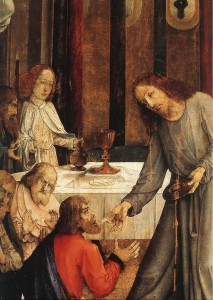 On these Sundays, the Liturgy proposes to us, from the Gospel of John, Jesus’ discourse on the Bread of Life, that is He Himself and that is also the Sacrament of the Eucharist. Today’s passage (Jn. 6, 51-58) presents the last part of that discourse, and refers to some of those among the people who are scandalized because Jesus said: “Whoever eats my flesh and drinks my blood has eternal life, and I will raise him on the last day” (Jn. 6,54).
On these Sundays, the Liturgy proposes to us, from the Gospel of John, Jesus’ discourse on the Bread of Life, that is He Himself and that is also the Sacrament of the Eucharist. Today’s passage (Jn. 6, 51-58) presents the last part of that discourse, and refers to some of those among the people who are scandalized because Jesus said: “Whoever eats my flesh and drinks my blood has eternal life, and I will raise him on the last day” (Jn. 6,54).
The astonishment of those listening is understandable; in fact, Jesus uses the typical style of the prophets to provoke in the people – and also in us – questions and, in the end, to make a decision. The first of the questions is: What does “eat Jesus’ flesh and drink his blood” mean? Is it only an image, a way of saying, a symbol, or does it indicate something real? To answer this, one needs to guess what is happening in Jesus’ heart while he breaks the bread for the hungry crowd. Knowing that He must die on the cross for us, Jesus identifies Himself with that broken and shared bread, and that becomes for Him the “sign” of the Sacrifice that awaits Him. This process culminates in the Last Supper, where the bread and wine truly become His Body and His Blood.
It is the Eucharist where Jesus leaves us a precise purpose: that we can become one with Him. In fact, he says: “Whoever eats my flesh and drinks my blood remains in me and I in him” (v.56). To remain: Jesus in us and us in Him. Communion is assimilation: eating Him, we become Him. But this requires our “yes”, our adherence to the faith.
At times, during the Holy Mass, it may happen to feel this objection: “What is the purpose of the Mass? I go in Church when I feel like it, and I pray better alone.” But the Eucharist is not a private prayer or a beautiful spiritual experience, it is not a simple commemoration of what Jesus has done in the Last Supper: we say, to understand well, that the Eucharist is a “memorial”, that is, an act that actualizes and makes present the event of the death and resurrection of Jesus: the bread is truly His Body given to us; the wine is truly His Blood that has been shed.
The Eucharist is Jesus who gives Himself entirely to us. By nourishing ourselves from Him and remaining in Him through the Eucharistic Communion, if we do it with faith, it transforms our life; it transforms it into a gift to God and a gift to our brothers. To nourish ourselves from that “bread of life” means being in tune with the heart of Christ, to assimilate His choices, His thoughts, His behavior. It means entering into a dynamic of sacrificial love and become a person of peace, of forgiveness, of reconciliation of sharing in solidarity. It is the same as Jesus has done.
Jesus concludes his discourse with these words; “Whoever eats this bread will live forever” (Jn. 6,58). Yes, living in a concrete, real communion with Jesus on this earth makes us pass from death to life. The heavens begin precisely in this communion with Jesus.
In Heaven, Mary our Mother awaits us – yesterday we celebrated this mystery. May She obtain for us the grace of nourishing ourselves always with faith in Jesus, the Bread of Life.
Jesus: I am the bread of life
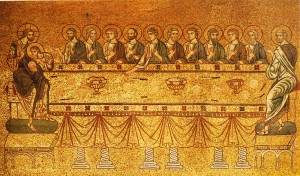 I love the gospel readings for the month of August because they give us the eucharistic theology of Divine Presence and the Divine Pledge for Eternal Life. These readings are known as the Bread of Life discourse taken from the Gospel of Saint John (chapter 6). You might say that the readings from Saint John’s gospel offers a timely reflection and orientation for eucharistic coherence. They indeed do, and this is no small gift these days when you hear more disagreement of what the Holy Eucharist is and why we receive Him. Faith informs me that sacramental Communion is Jesus Himself.
I love the gospel readings for the month of August because they give us the eucharistic theology of Divine Presence and the Divine Pledge for Eternal Life. These readings are known as the Bread of Life discourse taken from the Gospel of Saint John (chapter 6). You might say that the readings from Saint John’s gospel offers a timely reflection and orientation for eucharistic coherence. They indeed do, and this is no small gift these days when you hear more disagreement of what the Holy Eucharist is and why we receive Him. Faith informs me that sacramental Communion is Jesus Himself.
Whom do we receive in Holy Communion?
The question of what it means to be fed by the Bread of Life is not only a question for Holy Thursday, Corpus Christi or on the feast days of “eucharistic saints” like Saint Peter Julian Eymard. Today, the 19th Sunday Through the Church Year gives us the pericope that records the words of Jesus, and it is quite clear of who Jesus is and what the point is: “I am the bread that came down from heaven.” He also tells us: “I say to you, whoever believes has eternal life.”
Here is a paragraph from a Sermon by Eutychius of Constantinople:
No one, then, after the sacramental sacrifice and the holy resurrection, should have any doubt regarding the incorruptible, immortal, holy, and life-giving body and blood of the Lord. Once infused into the sacred elements through the liturgical rites, they communicate their own properties no less than do the aforementioned examples. They are wholly present in every part, for then the Lord’s body dwells corporally, that is to say, substantially, all the fullness of the divine nature of the Word of God. The breaking of this precious bread signifies his sacrificial death, and so he spoke of the passover as something to be longed for because it was to bring us salvation, immortality, and perfect knowledge.”
Jesus is the Bread of Life
 The first reading today for the sacred Liturgy of 18th Sunday Through the Church Year, reveals the pouring out from heaven of manna for the people of Israel. The manna, you will recall, is an Old Testament type for what is revealed by Jesus in the feeding narratives and then as the Holy Eucharist. A central image of Jesus in the Gospel of St. John (John 6:24-35) is that He is the Bread of Life; later we speak of this as the heavenly banquet, the spiritual food for eternal life, as a holy sacrament. Christians believe the OT typology is a direct prefiguring of what is revealed in the NT narratives where we read of Christ’s multiplications of bread, signs of Eucharist (Thanksgiving, of heavenly food on earth), of Jesus Christ being the Bread of Life.
The first reading today for the sacred Liturgy of 18th Sunday Through the Church Year, reveals the pouring out from heaven of manna for the people of Israel. The manna, you will recall, is an Old Testament type for what is revealed by Jesus in the feeding narratives and then as the Holy Eucharist. A central image of Jesus in the Gospel of St. John (John 6:24-35) is that He is the Bread of Life; later we speak of this as the heavenly banquet, the spiritual food for eternal life, as a holy sacrament. Christians believe the OT typology is a direct prefiguring of what is revealed in the NT narratives where we read of Christ’s multiplications of bread, signs of Eucharist (Thanksgiving, of heavenly food on earth), of Jesus Christ being the Bread of Life.
Saint Cyril of Alexandria teaches us that “In effect, Jesus is saying ‘I am the bread of life’, not bodily bread, which merely eliminates the physical suffering brought on by hunger, but rather that bread that refashions the entire living being to eternal life. The human being, who had been created for eternal life, is now given power over death.”
The good news here is that God, our Provident Father, provides for us in varied ways: He nourishes us and gives us the medicine of immortality.
The image is a striking one: it is a medieval illumination from the Morgan Bible called “Give Us This Day.” Indeed, may we worthily received the gift of the Bread of Life for our salvation.

